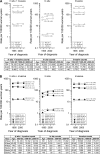Recent trends in breast cancer among younger women in the United States
- PMID: 19001605
- PMCID: PMC2720764
- DOI: 10.1093/jnci/djn344
Recent trends in breast cancer among younger women in the United States
Abstract
Increases in the incidence of postmenopausal breast cancers have been linked to screening and menopausal hormone use, but younger women have received less attention. Thus, we analyzed trends in breast cancer incidence (N = 387 231) using the National Cancer Institute's Surveillance, Epidemiology, and End Results Program 13-Registry database (1992-2004). Whites had higher incidence rates than blacks after age 40 years, but the reverse was true among younger women (black-white crossover). Among younger women, the rate per 100,000 woman-years was 16.8 for black vs 15.1 for white women; the highest black-white incidence rate ratio (IRR) was seen among women younger than 30 years (IRR = 1.52, 95% confidence interval = 1.34 to 1.73). This risk pattern was not observed in other ethnic groups. The black-white crossover among younger women was largely restricted to breast cancers with favorable tumor characteristics. The annual percentage change in the incidence of invasive breast cancers decreased modestly among older women but increased among younger (<40 years) white women. Continued surveillance of trends is needed, particularly for molecular subtypes that preferentially occur among young women.
Figures

Comment in
-
Re: Recent trends in breast cancer among younger women in the United States.J Natl Cancer Inst. 2009 May 6;101(9):691-2; author reply 692-3. doi: 10.1093/jnci/djp026. Epub 2009 Apr 28. J Natl Cancer Inst. 2009. PMID: 19401551 No abstract available.
References
-
- Klauber-DeMore N. Tumor biology of breast cancer in young women. Breast Dis. 2005;23((1)):9–15. - PubMed
-
- Surveillance, Epidemiology, and End Results (SEER) Program ( www.seer.cancer.gov) SEER*Stat Database: Incidence - SEER 13 Regs Limited-Use, Nov 2006 sub (1992–2004) - Linked To County Attributes – Total U.S., 1969–2004 Counties, National Cancer Institute, DCCPS, Surveillance Research Program, Cancer Statistics Branch, released April 2007, based on the November 2006 submission.
-
- Anderson WF, Matsuno RK, Sherman ME, et al. Estimating age-specific breast cancer risks: a descriptive tool to identify age interactions. Cancer Causes Control. 2007;18(4):439–447. - PubMed
-
- Tarone RE. Breast cancer trends among young women in the United States. Epidemiology. 2006;17(5):588–590. - PubMed
-
- Althuis MD, Brogan DD, Coates RJ, et al. Breast cancers among very young premenopausal women (United States) Cancer Causes Control. 2003;14(2):151–160. - PubMed

